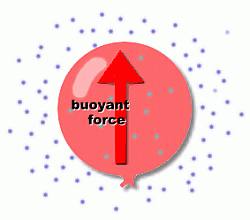  What makes a balloon want to go up? Simple! Whatever gas is inside the balloon has to be one which is less dense than the air outside.
What makes a balloon want to go up? Simple! Whatever gas is inside the balloon has to be one which is less dense than the air outside.If it's hot air inside the balloon, the hot air molecules move faster and spread out. Since they are farther apart, the hot air's mass for any given volume (its density) will be less. (See picture at right) If the gas inside the balloon is helium, these tiny particles are less dense because they are so tiny. A given volume of helium has very little mass, so its density is small. In both cases, the denser air in which the balloon floats supplies an upwards buoyant force on the less dense gas of the balloon, causing it to float upwards. Incidentally, both gases have their drawbacks. Hot air in a balloon will eventually cool to the temperature of the surrounding air, making the densities the same, and resulting in no more buoyant force. However, if you can keep the air hot, it will stay less dense, and the lifting force will remain. That's why hot air balloons that carry passengers always take along a heater. Helium molecules are so tiny that they can easily escape through microscopic holes in the rubber of the balloon. Years ago, makers of hot air balloons and blimps tried to use hydrogen gas, which is the least dense of any gas, resulting in a very large buoyant force. Unfortunately, hydrogen is very explosive, so it wasn't very safe. |